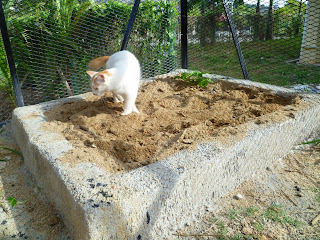Common wisdom (from trawling the internet) states that you shouldn't compost dog or cat faeces. Or if you do, make a separate composting system for it, make sure you compost is for more than 18 months, and even then, only use the compost for ornamental, not edible plants.
Common local wisdom (from speaking to nursery owners here) say they absolutely hate it when cats defecate or urinate on their plants/plant beds, as their waste is considered 'too heaty' and will make the plants die. Since my little bonsai pink frangipani did die after a rescued kitten pooped on it, I must somehow agree with that. But then again, that bonsai was the last of a long line of plants that I had successfully killed, so perhaps it wasn't healthy enough to survive the kitty assault. LOL.
But I came across these cat breeders, who claim they have successfully composted kitty litter for use on their potted plants and veggies (!) Man, those plants are thriving!
So, based on that, I stacked two 'bald' tyres I saved from my previous car tyre change, and started a compost heap. In the heap, I put:
- coconut husk
- cat poop
- cat litter waste (I used pine pellets, this was when I had the cats indoors)
- kitchen waste (veggie peelings, spent grated coconut, crushed egg shells)
- shredded paper (unbleached, used to wrap my veggie purchases)

Bubu on the runway.. er makeshift compost heap. She also uses it as a scratching post.
I turn the pile once in a while (once every few days). And since this heap is in the cat enclosure, some of my cats have helpfully started to poop there instead of in their outdoor kitty sandbox. I am not worrying too much about ratios here, since I figure our hot and humid climate will help anything decompose. Eventually. *grin* Since mosquito breeding is a problem here (dengue cases are frequent) I made sure to fill the inside edges of the tyres that might collect rainwater (and thus provide a breeding ground for mosquitos) with the ground coconut husk. The system has been in place for about two weeks now, and there seem to be no pools of mosquito-friendly still water with the tyres.There are some worries that one might inadvertantly get some Toxoplasma gondii oocytes (which cause toxoplasmosis, a well-known disease from cats) from the kitty waste onto your leafy greens, and ultimately into your dinner plate. According to Fox (quoting Dubey, 1998) in 'The Mouse in Biomedical Diseases' in the section on the sterilising of mice bedding (because mice can get toxoplasmosis too), T. gondii oocytes lose infectivity at temperatures above 40 degrees Celcius. Now, since compost heap temperatures have been known to be between 40-70 degrees Celcius, I guess if I make sure the compost matures properly, at the right temperatures, toxoplasmosis should not be a problem.
 Toshi looking for a good spot in the kitty sandbox. In the far corner is the wild 'bunga telang' plant.
Toshi looking for a good spot in the kitty sandbox. In the far corner is the wild 'bunga telang' plant.Would I actually eat the peas from the plant growing in my kitty sandbox? I haven't actually decided yet, although I have heard the urban legend that mung bean sprouts are grown on sheets of woven sacks fertilised with human pee. And I have definitely eaten commercially grown bean sprouts and survived to tell the tale. Would I eat veggies fertilised with my kitty compost? I think I would. All manner of animals have pooped/peed in kitchen backyards for ages now, I think the composted version would be safe(er). But I will wash my veggies thoroughly though, just in case!


2 comments:
This is new to me. I mean using kitty waste to add to compost.
Bunga telang is not only pretty but useful. Good plant choice. Happy composting and gardening!
Thanks for dropping by, Stephanie. :-) I guess not many people have done it and wrote about it, which made that article such a Godsend. I am learning as I go along.
Post a Comment